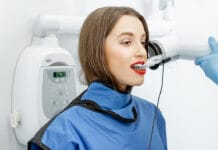Have you ever thought about the amount of waste a dental practice produces? It can be hard to ignore when a large part of our day is dedicated to cleaning and changing over rooms for the next patient. For the sake of time efficiency and maximizing cleanliness, disposable barriers, single-use products, and chemical-laden cleaning agents have become essential. However, human and environmental health are linked in such a way that we cannot overlook the need to reduce the waste and carbon footprint of dental hygiene in any way possible.
Carbon dioxide is part of a group of gases known as greenhouse gases. These are any gas that absorbs infrared radiation, solar heat, or radiated heat, preventing heat from being lost from the planet. This causes a greenhouse effect or global warming.2
The global warming potential (GWP) of these gases is based on the amount of warming a gas causes over a given period. In comparison, carbon dioxide is assigned an index value of one, and nitrous oxide has a GWP 298 times that of carbon.2 A carbon footprint is the amount of carbon dioxide and other carbon compounds emitted due to the consumption of fossil fuels by a particular person or group.
Greenhouse gas emissions negatively impact public health by increasing the prevalence of extreme weather, flooding, and vector-borne disease, among other things. The World Health Organization estimates 250,000 deaths will occur between 2030-2050 due to climate change and factors such as malaria, malnutrition, cardiovascular disease, and heat stress.3
Dentistry’s Footprint
Dentistry is included with the healthcare sector contributing approximately 3% of the 10% carbon footprint healthcare creates annually in the United States.2 The United States is second only to China in greenhouse gas emissions that contribute to global warming and climate change.6 Due to rising costs, increasing demand, and high environmental burden, current healthcare delivery methods are not sustainable.2
Dental hygiene uses excessive amounts of water and energy. Other dental wastes come from procedures that generate metallic waste, and biomedical waste like gloves, sharps, and dental materials.1,5
The top four areas of dental waste are:5
- Placement or removal of mercury-containing dental materials
- Conventional radiography systems (unused fixer, lead foil film packs)
- Infection control methods (disposable barriers, toxic disinfectants)
- Conventional vacuum saliva ejection systems
An environmentally sustainable office is not impossible to attain; there are many small ways to begin to reduce the carbon footprint of your practice or clinic. Look for non-toxic and minimally-invasive options. Focus on renewability, sustainability, and energy efficiency. The ADA offers 80 tips to begin reviewing how to implement green dentistry, and the Eco-Dentistry Association is a great resource for information, printing, products, and energy-efficient equipment.4,7
The four R’s are a good place to start evaluating needed changes:1,5
- Reduce: Minimize outgoing waste, reduce aerosols, switch to digital records, and radiography. Digital radiography creates 70% to 90% less radiation than conventional x-rays and eliminates the need for film packs and several chemical waste factors.
- Reuse: Replace single-use items with reusable where possible. Switch to stainless steel impression trays, autoclavable cassettes and pouches, cloth bibs and headrest covers, metal air-water tips, autoclavable bib clips, and glass irrigation syringes.
- Recycle: Anything from paper to metal. Purchase printed products that are recyclable or made from recycled materials. Sharpen instruments often and check into recycling options when it is time to replace.
- Rethink: Use materials as directed to minimize waste and follow disposal instructions properly. Always explore environmentally sustainable items for any purchase.
Green dentistry is not just good for the environment; over time, it may prove beneficial to the bottom line. If building an office, consider durable linoleum flooring, high-efficiency air systems, LED bulbs, tinted windows, and energy-efficient equipment to reduce energy consumption and future utility bills.
Sustainability is marketable as well. Research shows that more than a third of the U.S. population actively invest in environmentally friendly options, and three-fourths of millennials polled were willing to spend more for options that are sustainable.2,4
As dental hygienists, our public position allows us to spread awareness about climate change and resulting health effects.3 Speaking to patients about something as simple as turning off their faucet while brushing or recommending products and companies that are environmentally sustainable is the small spark that leads to effectual positive change. Let’s be a part of it!
Before you leave, check out the Today’s RDH self-study CE courses. All courses are peer-reviewed and non-sponsored to focus solely on high-quality education. Click here now.
Listen to the Today’s RDH Dental Hygiene Podcast Below:
References
- Arora, S., Mittal, S., Dogra, V. Eco-friendly dentistry: Need of future. An overview. J Dent Allied Sci. 2017; 6: 22-7. Retrieved from http://www.jdas.in/article.asp?issn=2277-4696;year=2017;volume=6;issue=1;spage=22;epage=27;aulast=Arora
- Duane, B., Harford, S., Ramasubbu, D., Stancliffe, R., Pasdeki-Clewer, E., Lomax, R., Steinbach, Inge. Environmentally sustainable dentistry: a brief introduction to sustainable concepts within the dental practice. British Dental Journal. 2019; 226: 292-295. doi:10.1038/s41415-019-0010-7.
- Eckelman, M., Sherman, J.D. Estimated Global Disease Burden from US Health Care Sector Greenhouse Gas Emissions.American Journal of Public Health. 2018;108(S2), S120–S122. Retrieved from https://doi.org/10.2105/ajph.2017.303846
- Eco Dentistry Association. (2016). Retrieved from https://ecodentistry.org/
- Rastogi, V., Sharma, R., Yadav, L., Satpute, P., Sharma, V. (2014). Green dentistry, a metamorphosis towards an eco-friendly dentistry: a short communication. Journal of clinical and diagnostic research: JCDR. 8(7): ZM01–ZM2. doi:10.7860/JCDR/2014/8084.4556.
- Inventory of U.S. Greenhouse Gas Emissions and Sinks. United States Environmental Protection Agency. Retrieved from https://www.epa.gov/ghgemissions/inventory-us-greenhouse-gas-emissions-and-sinks
- 80 Ways to Make Your Dental Practice Green. ADA Center for Professional Success. 2020. Retrieved from https://success.ada.org/en/practice-management/office-design/80-ways-to-make-your-dental-practice-green











